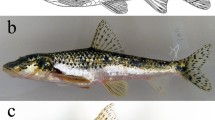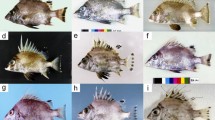Abstract
In this study, seven species of Pomadasys from the Persian Gulf and the Gulf of Oman are examined. This genus includes species with high economic and ecological importance, and taxonomical challenges are due to their very similar meristic features. Three species of Pomadasys aheneus, P. furcatus and P. olivaceus are reported for the first time from the Iranian waters of the Persian Gulf and the Gulf of Oman. These rare species were collected from coastal rocky habitats in 5–12 m water depth. This paper presents detailed description of seven Pomadasys species including morphological characters, distribution, photographs, along with identification key. The results of univariate and multivariate analyses were in relatively high agreement, indicating significant difference in the number of gill rakers, the number of tubed lateral-line scales, body depth, snout length, second and fifth dorsal-fin spine length, caudal-fin length and pectoral-fin length among the species. The variation in body shape showed a significant correlation with ecomorphological diversification. Species diversity of the Persian Gulf is low as compared with the Gulf of Oman which can be due to ecological factors and habitat structure.










Similar content being viewed by others
References
Ali AH, Iwatsuki Y (2018) Record of the Yellowback Grunt Pomadasys aheneus McKay & Randall (Osteichthyes: Haemulidae) from the Arabian Gulf off Iraq. Zool Middle East 64:371–373. https://doi.org/10.1080/09397140.2018.1462600
Arvedlund M (2009) First records of unusual marine fish distributions: can they predict climate changes? J Mar Biol Assoc U K 89:863–866. https://doi.org/10.1017/S002531540900037X
Barik TK, Swain SN, Sahu B, Tripathy B, Acharya UR (2018) First Record of Tylosurus crocodilus (Péron & Lesueur, 1821) (Beloniformes: Belonidae) from Odisha Coast, Bay of Bengal, India: Exploration of a Biological Invasion Using DNA Barcoding. Thalassas 34:209–217. https://doi.org/10.1007/s41208-017-0053-y
Barth HJ, Khan NY (2008) Biogeophysical setting of the Gulf. In: Protecting the Gulf’s marine ecosystems from pollution. Birkhäuser Basel, pp 1–21.
Bauchot ML (2003) Haemulidae. p. 495-503 In C. Lévêque, D. Paugy and G.G. Teugels (eds.) Faune des poissons d'eaux douce et saumâtres de l'Afrique de l'Ouest, Tome 2. Coll. Faune et Flore tropicales 40. Musée Royal de l'Afrique Centrale, Tervuren, Belgique, Museum National d'Histoire Naturalle, Paris, France and Institut de Recherche pour le Développement, Paris, France, 815 pp.
Benny PN (2002) Variability of Western Indian Ocean currents. Western Indian Ocean. J Mar Sci 1:81–90
Blegvad H, Loppenthin B (1944) Fishes of the Iranian Gulf. Danish Scientific Investigations in Iran. Einar Munksgaard, Copenhagen, p 247
Burt JA, Feary DA, Bauman AG, Usseglio P, Cavalcante GH, Sale PF (2011) Biogeographic patterns of reef fish community structure in the northeastern Arabian Peninsula. ICES J Mar Sci 68:1875–1883. https://doi.org/10.1093/icesjms/fsr129
Carpenter KE, Krupp F, Jones DA, Zajonz U (1997) FAO Species identification Field Guide for Fishery Purposes: The Living Marine Resources of Kuwait, Eastern Saudi Arabia, Bahrain, Qatar, the United Arab Emirates. Rome, Food and Agriculture Organization of the United Nations, pp 324.
Coles S (2003) Coral species diversity and environmental factors in the Persian Gulf and the Gulf of Oman: a comparison to the Indo-Pacific region. Atoll res bull 507:1–19
Damadi E, Yazdani Moghaddam F, Ghassemzadeh F, Ghanbarifardi M (2020) Plectorhinchus makranensis (Teleostei, Haemulidae), a new species of sweetlips from the Persian Gulf and the Gulf of Oman. ZooKeys 980:141–154. https://doi.org/10.3897/zookeys.980.50934
Eagderi S, Fricke R, Esmaeili HR, Jalili P (2019) Annotated checklist of the fishes of the Persian Gulf: Diversity and conservation status. Iran J Ichthyol 6:1-171. https://doi.org/10.22034/iji.v6i0.454.
Feary D, Burt JA, Bauman A, Usseglio P, Sale PF, Cavalcante G (2010) Fish communities on the world’s warmest reefs: what can they tell us about impacts of a climate change future? J Fish Biol 77:1931–1947. https://doi.org/10.1111/j.1095-8649.2010.02777.x
Fricke R, Mahafina J, Behivoke F, Jaonalison H, Léopold M, Ponton D (2018) Annotated checklist of the fishes of Madagascar, southwestern Indian Ocean, with 158 new records. FishTaxa 3:1–432
Fricke R, Eschmeyer WN, van der Laan R (2020) Catalog of fishes: genera, species, references.http://researcharchive.calacademy.org/research/ichthyology/catalog/fishcatmain. Accessed 3 August 2020.
Ghanbarifardi M, Malek M (2009) Distribution, diversity, and abundance of rocky intertidal fishes in the Persian Gulf and Gulf of Oman. Iran. Mar Biol Res. 5:496–502. https://doi.org/10.1080/17451000802441293
Ghanbarifardi M, Aliabadian M, Esmaeili HR (2018) Phylogeography of Walton’s Mudskipper, Periophthalmus waltoni Koumans, 1941 (Perciformes: Gobiidae), from the Persian Gulf and Gulf of Oman. Zool Middle East 64:207–218. https://doi.org/10.1080/09397140.2018.1470300
Gloerfelt TT, Kailola PJ (1984) Trawled fishes of southern Indonesia and Northwestern Australia. Australian Development Assistance Bureau, Australia, Directorate General of Fishes, Indonesia, and German Agency for Technical Cooperation. Federal Republic of Germany, p 407
Golani D, Fricke R (2018) Checklist of the Red Sea fishes with delineation of the Gulf of Suez, Gulf of Aqaba, endemism and Lessepsian migrants. Zootaxa 4509:1–215. https://doi.org/10.11646/zootaxa.4509.1.1
Hammer O (2020) PAST paleontological statistics v.4.03. Reference Manual. Oslo: University of Oslo.
Jawad LA, Al Badri ME, Fricke R (2014) new records of thicklips and grunts from the marine waters of Iraq (Teleostei: Haemulidae). J Ocean Sci Found 12:18–24
Johnson JW, Wilmer JW (2015) Plectorhinchus caeruleonothus a new species of sweetlips (Perciformes: Haemulidae) from northern Australia and the resurrection of P. unicolor (Macleay 1883) species previously confused with P. schotaf (Forsskål 1775). Zootaxa 3985:491–522. https://doi.org/10.11646/zootaxa.3985.4.2
Karimi S, Katiraei E, Soofiani NM, Taghavimotlagh SA, Vazirizadeh A (2019) Feeding habits of striped piggy, Pomadasys stridens (Forsskal, 1775) (Haemulidae) in northern part of the Persian Gulf. Int J Aquat Biol 7:85–92
Konchina Y (1977) Some data on the biology of grunts (family Pomadasyidae). J Ichthyol 17:548–448
KulbicKi M, Moriz EE, Wantiez L (2009) Synopsis of the biology and ecology of Pomadasys argenteus (Haemulidae) in New Caledonia. Cybium 33:45–59
Ludt WB, Rocha LA (2015) Shifting seas: The impacts of Pleistocene sea level fluctuations on the evolution of tropical marine taxa. J Biogeogr 42:25–38. https://doi.org/10.1111/jbi.12416
Maghsoudlou A, Momtazi F, Nasiri K, Pazooki S, Molavi-Arabshahi M, Sepahvand V, Khaledi H (2019) A review on the state of the biodiversity knowledge on Iran’s southern seas: introducing a methodology to evaluate the validity of the reported cases. Mar Biodivers 49:563–581. https://doi.org/10.1007/s12526-017-0835-8
Manilo LG, Bogorodsky SV (2003) Taxonomic composition diversity and distribution of coastal fishes of the Arabian Sea. J Ichthyol 43:75149
McKay RJ (1983) Haemulidae. FAO species identification sheets for fisheries purposes. Western Indian Ocean (Fishing Area 51), 2-10 pp.
McKay RJ (2001) Haemulidae (= Pomadasyidae). Grunts (also sweetlips, rubberlips, hotlips, and velvetchins), in: Carpenter, K.E., Niem, V.H. (Eds.), FAO Species Identification Guide for Fishery Purposes. The Living Marine Resources of the Western Central Pacific. Volume 5. Bony Fishes Part 3 (Menidae to Pomacentridae). FAO, Rome, pp 2961–2989.
McKay RJ, Randall JE (1995) Two new species of Pomadasys (Pisces: Haemulidae) from Oman, with a redescription of P. punctulatus (Rüppell). Mem Queensl Mus 38:251–255
Monjezi Veysi M, Mahboobi Soofiani N, Valinassab T, Daryanabard GR (2017) Determination of CPUA and distribution pattern of families Haemulidae, Nemipteridae and Ariidae in the Oman Sea. Iran J Fish Sci 16:1297–1311
Nelson JS, Grande TC, Wilson MV (2016) Fishes of the World. John Wiley & Sons, Hoboken, New Jersey
Paighambari SY, Daliri M, Pouladi M, Madah Arefi H (2018) Length–weight Relationships of four marine fish species in the Gulf of Oman (Konarak, Iran). J Appl Ichthyol 34:1007–1008. https://doi.org/10.1111/jai.13637
Parenti P (2019) an annotated checklist of the fishes of the family Haemulidae (Teleostei: Perciformes). Iran J Ichthyol 6:50–196
Polgar G, Ghanbarifardi M, Milli S, Agorreta A, Aliabadian M, Esmaeili HR, Khang TF (2017) Ecomorphological adaptation in three mudskippers (Teleostei: Gobioidei: Gobiidae) from the Persian Gulf and the Gulf of Oman. Hydrobiologia 795:91–111. https://doi.org/10.1007/s10750-017-3120-8
Price SA, Tavera JJ, Near TJ, Wainwright PC (2013) Elevated rates of morphological and functional diversification in reef dwelling haemulid fishes. Evolution 67:417–428. https://doi.org/10.1111/j.1558-5646.2012.01773.x
Psomadakis P, Thein H, Russell BC, Tun MT (2020) Field identification guide to the living marine resources of Myanmar. FAO species identification guide for fishery purposes. FAO, Rome.
Randall JE (1995) Coastal fishes of Oman. Crawford House Publishing Pty Ltd Bathurst, 439 pp
Reynolds RM (1993) Physical oceanography of the Gulf, Strait of Hormuz, and the Gulf of Oman results from the Mt Mitchell expedition. Mar Pollut Bull 27:3559
Sfakianakis DG, Leris I, Kentouri M (2011) Effect of developmental temperature on swimmingperformance of zebrafish (Danio rerio) juveniles. Environ Biol Fishes 90:421–427
Tavera J, Acero A, Wainwright PC (2018) Multilocus phylogeny, divergence times, and a major role for the benthic-to-pelagic axis in the diversification of grunts (Haemulidae). Mol Phylogenet Evol 121:212–223. https://doi.org/10.1016/j.ympev.2017.12.032
Torquato F, Range P, Ben-Hamadou R, Sigsgaard EE, Thomsen PF, Riera R et al (2019) Consequences of marine barriers for genetic diversity of the coral specialist yellowbar angelfish from the Northwestern Indian Ocean. Ecol Evol 9:11215–11226. https://doi.org/10.1002/ece3.5622
Zajonz U, Lavergne E, Bogorodsky SV, Saeed FN, Aideed MS, Krupp F (2019) Coastal fish diversity of the Socotra Archipelago, Yemen. Zootaxa 4636:1–108. https://doi.org/10.11646/zootaxa.4636.1.1
Acknowledgements
The authors are especially grateful to Hamid Badar Osmany for help in collecting fresh specimens from Karachi, Pakistan. We would like to thank local fishermen for their help in collecting specimens. The authors also are grateful for editorial help from Ms. Christine McLennan during the revision of the manuscript.
Funding
Funding support for this research was provided by the Iran National Science Foundation (number grant 97009791).
Author information
Authors and Affiliations
Corresponding author
Ethics declarations
Conflict of Interest
The authors declare that they have no conflict of interest.
Additional information
Publisher’s Note
Springer Nature remains neutral with regard to jurisdictional claims in published maps and institutional affiliations.
Rights and permissions
About this article
Cite this article
Damadi, E., Moghaddam, F.Y., Ghassemzadeh, F. et al. Aspects of morphometry, distribution, and key identification of the genus Pomadasys (Perciformes: Haemulidae) from the Persian Gulf and Gulf of Oman with descriptions of new records. Thalassas 37, 671–682 (2021). https://doi.org/10.1007/s41208-021-00308-1
Received:
Revised:
Accepted:
Published:
Issue Date:
DOI: https://doi.org/10.1007/s41208-021-00308-1




